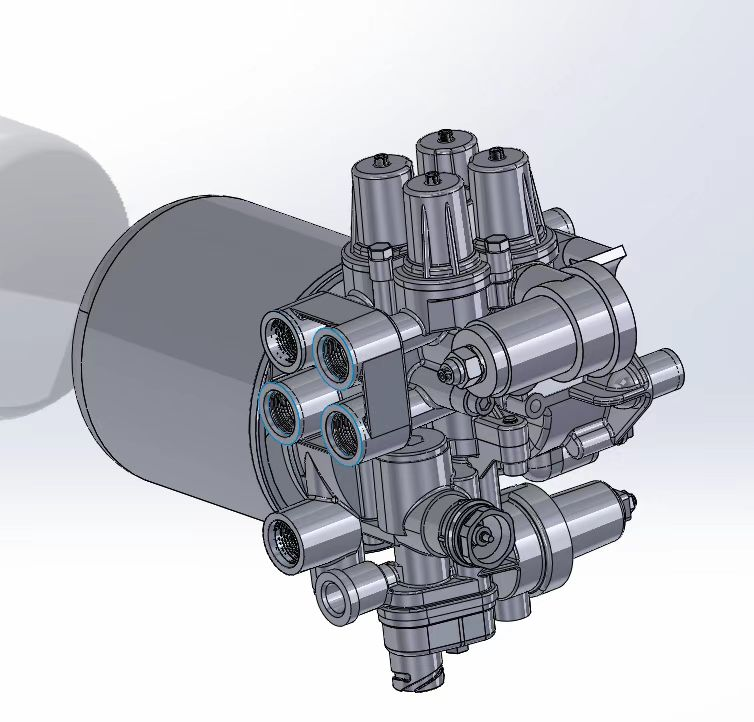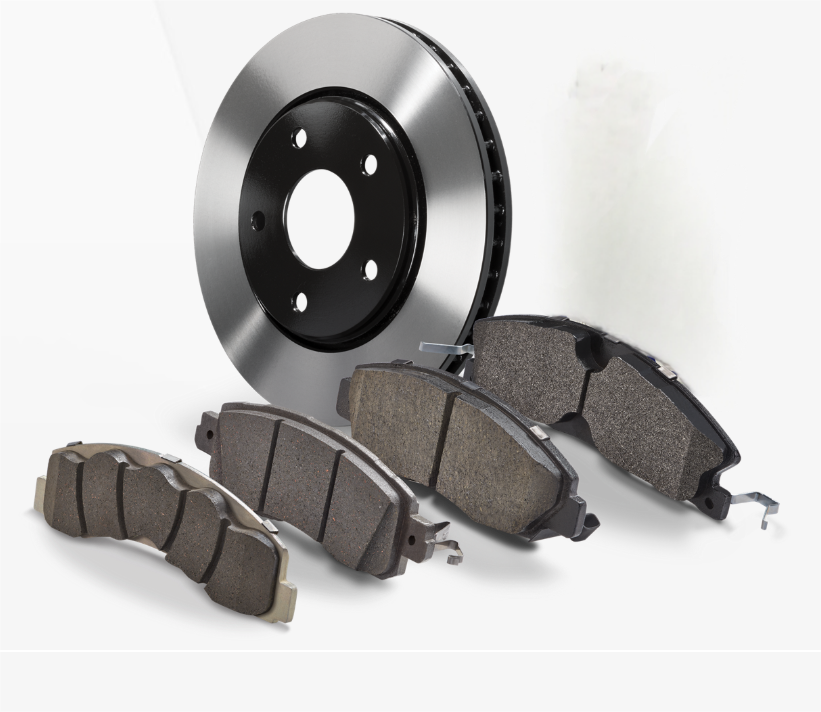Understanding Brake Pad Materials and Types
Organic Brake Pads: Quiet Performance for Light Use
Organic brake pads made from rubber, carbon stuff, and various resins deliver quieter braking compared to other types. They work best on smaller cars and vehicles that spend most time in city traffic because they don't make much noise and tend to be cheaper upfront. The price tag is definitely lower than some alternatives, plus they weigh less which helps save on gas costs. But there's a catch these pads wear down faster when pushed hard or exposed to extreme heat. That's why serious performance enthusiasts usually skip them for track days or towing heavy loads. Still plenty of regular folks pick organic pads for their everyday commute since nobody wants to hear constant screeching from under the hood while stuck in traffic jams.
Semi-Metallic Brake Pads: Durability for Heavy-Duty Needs
Semi metallic brake pads contain metal fibers which give them better lasting power and help dissipate heat much better than other options. Because of this design, they work really well on big rigs and commercial trucks that need strong brakes when carrying heavy loads over long distances. The stopping power these pads deliver beats out regular organic pads, especially when temperatures fluctuate between hot summer days and cold winter nights across different road surfaces. On the downside though, they tend to make more noise during operation and leave behind quite a bit of brake dust. For this reason, most mechanics recommend them for industrial applications or situations where drivers aren't bothered by the extra noise. Industry reports show that fleet operators prefer these pads for their vehicles operating in tough conditions day after day.
Ceramic Brake Pads: Low Dust and Longevity
People love ceramic brake pads because they're made from really dense ceramic stuff that creates way less dust and runs much quieter than other options. Compared to organic or semi-metallic pads, these bad boys last longer too since they can take the heat better without losing their grip. Most regular folks who drive around town day after day are starting to switch over to ceramics simply because they don't need replacing as often and basically take care of themselves. They work great in both city traffic where brakes get hot all the time and on highways where consistent stopping power matters. Sure, ceramic pads will cost more upfront, but many drivers find it worth the extra cash. Mechanics report seeing more and more cars coming in with ceramic installations lately, particularly among commuters looking for something reliable that won't hassle them with constant adjustments or replacements during normal daily driving.
High-Performance Brake Pads: Track-Ready Solutions
Performance brake pads designed for harsh conditions offer outstanding stopping power needed by sports cars and race vehicles. These pads can handle the serious heat that builds up when brakes are slammed repeatedly during races or when driving at top speeds on tracks. Sure, they tend to create more noise and leave behind noticeable dust compared to standard pads, but most serious drivers consider this tradeoff worth it. For anyone who regularly hits the racetrack or participates in competitive events, these specialized pads simply cannot be beat. Mechanics and gear heads across the country consistently rate them among the best options available for cars that need dependable braking when pushed to their limits. Enthusiasts looking to squeeze every bit of performance out of their braking systems find these pads deliver exactly what they promise.
Key Factors in Brake Pad Selection
Driving Habits: Commuting vs. Performance Driving
The type of brake pads someone chooses really depends on their driving style. Regular commuters might find organic brake pads work well since they tend to be quieter during everyday use. On the other hand, drivers who enjoy pushing their vehicles harder or frequently drive at higher speeds usually benefit from high performance brake pads that deliver extra stopping power when needed most. These performance oriented pads create more friction which is great for spirited driving but comes at a cost. Studies show that people who drive aggressively wear out their brake pads much faster than average, particularly when using softer materials. Understanding one's own driving patterns makes all the difference in picking the right brake pads and planning replacement schedules accordingly.
Vehicle Weight and Towing Requirements
People who drive heavier cars or regularly tow things need to pick brake pads that can stand up to the extra pressure. Semi metallic or high performance pads tend to work better because they're built tougher and handle added weight without overheating. Standard brake pads just don't last as long when dealing with heavy loads. The math checks out vehicle weight directly affects how fast regular brake pads wear down, which means mechanics see these parts replaced much more often on bigger vehicles. So anyone operating a truck or SUV should seriously consider investing in quality brake pads from day one. Better pads mean safer stops and fewer trips back to the garage for replacements down the road.
Climate: Heat Resistance and Cold Weather Performance
The climate where we live really matters when picking out brake pads since they work differently depending on what kind of weather we're dealing with. Semi metallic ones tend to handle heat better, which makes sense why people in hotter regions often go for these types. On the flip side, organic brake pads sometimes struggle in colder temperatures. Some research points out that brake effectiveness drops off quite a bit when temps get freezing, so checking what kind of winters our area typically has before buying pads makes good sense. Matching up the right pad material to local weather patterns helps keep things running smoothly through all seasons without compromising safety on the road.
Vehicle-Specific Brake Pad Considerations
Best Brake Pads for Trucks and SUVs
Picking the right brake pads matters a lot when dealing with trucks and SUVs because these beasts tend to weigh a ton and haul even more stuff around. Most mechanics will point folks toward semi-metallic brake pads since they stand up better to all that extra weight. These particular pads can take quite a beating from bigger vehicles without falling apart, so drivers get decent stopping power even when things get rough on the road. People who regularly pull trailers or load up their rigs know this firsthand – those semi-metallic options just last longer before needing replacement. Bottom line? Match the brake pad type to how someone actually uses their truck or SUV. Get it wrong and everyone involved might find themselves stuck somewhere unpleasant while waiting for roadside assistance.
High-Performance Vehicles: Managing Extreme Heat
When pushing high-performance cars to their limits, regular brake pads just won't cut it against the massive heat buildup from hard stops and track days. Brake fade remains a real danger when stopping power drops off suddenly, so going with performance-grade brake pads makes absolute sense. These specialized pads incorporate materials that actually handle heat better, keeping brakes working properly even when temperatures skyrocket. Motorsport engineers have seen time and again what happens when drivers skip proper pad upgrades the results are dangerous situations where stopping distance increases dramatically. The bottom line? Picking quality brake pads isn't just about getting better performance figures it's fundamentally about keeping everyone safe behind the wheel.
Daily Drivers: Balancing Cost and Comfort
Finding the sweet spot between what people actually pay and how comfortable their ride feels matters a lot when picking out brake pads for regular cars. Most folks driving around town every day gravitate toward ceramic brake pads because they last longer and don't make those annoying squeaky sounds that metal ones do. Sure, ceramic pads cost more upfront, but think about it this way: mechanics aren't coming around as often to replace them, which saves cash down the road. Mechanics we've talked to say good quality pads generally pay for themselves after a couple years since they wear down so much slower than cheaper alternatives. So if someone spends most of their time just getting from point A to point B during rush hour, ceramic brake pads make sense economically while still keeping things quiet inside the car cabin.
Ensuring Compatibility with Your Brake System
Rotor Size and Caliper Specifications
Getting the right brake pads that match both the rotor size and caliper specs on your car makes all the difference for good braking and staying safe on the road. When they don't fit properly, the pads tend to wear out unevenly, which might actually make the brakes work less well and put drivers at risk. Take rotor size differences for example – research shows these can really affect how far it takes to stop the car, which means getting exact measurements matters a lot when shopping for new pads. Bottom line? Double check compatibility between brake pads, rotors, and calipers before installation to get consistent stopping power every time.
OEM vs. Aftermarket Fitment Guidelines
Knowing what separates OEM brake pads from those made by third party manufacturers really matters when picking out replacement parts. The factory installed ones come with guarantees about how well they'll fit and perform since they're built specifically for each car model. Aftermarket alternatives give drivers more options though, often at lower prices too. People looking for budget friendly solutions find this appealing. But there's something important to remember here. Some real world testing shows that cheaper brake pads don't always hold up as well over time. We've seen cases where poor quality pads wore down faster than expected, which can create dangerous situations on the road. When shopping around, take time to compare specs side by side rather than just going for whatever looks cheapest upfront. Your braking system deserves nothing less than reliable components.
Maintenance and Replacement Best Practices
Signs of Wear: Squealing, Vibrations, and Reduced Stopping Power
Knowing when brake pads start wearing down matters a lot for drivers. Common warning signs include those annoying squeals when braking, strange vibrations while pressing the pedal, and longer stopping distances than usual. These aren't just irritating sounds or feelings they actually signal that replacement time might be coming soon. Drivers who ignore these warnings put themselves at greater risk on roads everywhere, which is why spotting them early makes all the difference for staying safe behind the wheel. Most mechanics recommend checking brakes regularly anyway, since catching small problems before they become big ones saves money in repairs later and keeps everything running smoothly much longer.
When to Replace Brake Pads: Mileage and Inspection Tips
Getting brake pads replaced at the right moment makes all the difference for safety on the road and how well the car stops. Most mechanics suggest changing them somewhere around 30k to 70k miles mark, but this really depends on what kind of material the pads are made from and how someone drives day to day. Take semi trucks for example their heavy duty brake systems often require more frequent checks compared to regular passenger cars because they carry much heavier loads. Mechanics always stress regular inspections as part of routine maintenance since these checks show exactly how worn down the pads have become over time. Skipping these appointments puts drivers at real risk of sudden brake failure when they least expect it, which nobody wants during rush hour traffic or long highway trips.
Extending Lifespan: Proper Bed-In Procedures and Cleaning
Getting more miles out of brake pads isn't simply about replacing them when they get worn down. The right bed-in procedure makes all the difference for how well they actually work. After installing new brake pads, drivers need to slowly apply pressure on the brakes several times to let the material transfer evenly onto the rotor surface. This creates better contact between pad and rotor over time. Cleaning those same components regularly matters too since dirt and grime build up fast, especially around city driving conditions. A quick wipe down now and then keeps things running smoothly instead of letting small particles grind away at expensive parts. Most mechanics will tell anyone who asks that keeping brake systems clean extends their life span considerably while also making sure stops happen safely every single time.







